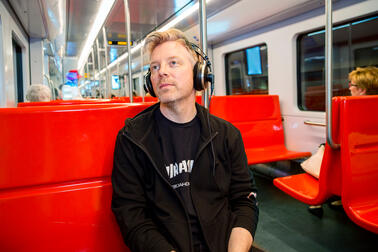
Even a loved one can hurt you. Violence in close relationships is what we talk about when the perpetrator and victim are, or have been, in a close relationship.
Recognising violence in close relationships often needs for some “detective work”. This is how Kaisla Kulmanen, a school social worker at the Diakonia College of Finland in Helsinki, describes the issue. In her work, she meets numerous upper secondary level students.
Once, a 16-year-old student came to Kulmanen to find out how an underaged person could move out on their own. Talking with the school social worker unravelled the truth: the student was a victim of violence in a close relationship.
"This is an example of a typical scenario. Not even once has a student come to me and started with ‘I’m a victim of violence in close relationships’. That's why it's important to listen closely and identify even the smallest signs of a problem. Unless the professional asks directly about it, violence in close relationships does not come up."
Kulmanen has also faced honour-based violence in her work on a few occasions, in which the family, immediate or extended, is involved. Honour-based violence is a form of social violence, in which an individual is violently controlled by their family, extended family or other community, accusing them of behaviour that goes against their cultural expectations.
"It is important for different parties in society to have the skills and understanding to engage with people that experience violence in close relationships. If the victim’s mobility is controlled, their school or place of study may be the only places where they can seek help."
Kulmanen is part of the City of Helsinki's key person network, which has members from different fields that work to prevent violence.
Key person network of professionals from many fields
The City of Helsinki works to eliminate and prevent violence in close relationships. One part of the work is the key person network, which was established this spring.
"We train different people working for the city of Helsinki, in the Helsinki wellbeing services county, and in NGOs. The aim is to give professionals the readiness to bring up violence in close relationships and therefore allow more and more people to receive help. Pilots for the training model will take place in different wellbeing services counties. The project is coordinated by the National Institute for Health and Welfare," says Ilona Fagerström, the City of Helsinki’s Coordinator for the Prevention of Violence in Close Relationships.
Studies show that professionals may not always know how to deal with victims of violence in close relationships or its perpetrators in the best possible way.
"For example, a tired mother may express a concern at the maternity and child health clinic that she is afraid of behaving violently towards her child. In that situation, it is necessary that the healthcare worker has the capacity to intervene."
The key person network, launched by the City of Helsinki, wants to expose violence in close relationships everywhere: in homes, schools, hobbies and workplaces.
According to Fagerström, anyone can experience violence in close relationships. It is not a matter of education, wealth, age or social class.
"Statistics show that women experience more serious and longer-lasting violence in close relationships more often than men. The younger the victim, the more traumatising its effects tend to be."
Perpetrators also need help
In the spring, the City held the first training session for the key person network. Four half-day meetings and a final seminar brought together over a dozen professionals from different fields. School social workers, teachers and healthcare professionals alike were involved. The first training period was specifically aimed at people that work with children and families.
As an organiser of the training Fagerström felt that the feedback was positive.
"We also had two people with lived experience present – a victim and a perpetrator. What they had to say was eye-opening."
Kulmanen, who participated in the training, agrees. In her opinion, it is important to look at violence as a whole and remember that the perpetrator also needs help.
"The training emphasised the fact that each of us has some kind of connection to violence in close relationships. If you have not personally experienced it, someone close to you has. Violence in close relationships is not something that happens somewhere else to someone you don’t know."
Kulmanen also praises the training for bringing professionals from different fields together.
"It was interesting to talk about how to navigate these delicate situations. We have a duty to report in violence in close relationships, especially if the case involves minors. On the other hand, as professionals, we have a duty to remain confidential. That confidence is extremely important – you must always act in the best interest of the customer."
How to bring up violence
Ilkka Määttä is a specialist in anti-violence work at Pääkaupungin turvakoti ry, an association that provides shelters and counselling for victims. He was one of the trainers at the training event for the key person network this spring. Määttä is satisfied with the multi-professional cooperation.
"I hope that the key person network spreads to different parts of Finland. In order to eliminate violence in close relationships, it is important to cooperate with the authorities, healthcare workers, as well as NGOs."
Määttä brings up three important steps in anti-violence work. These themes were a part of the spring training.
First, it is necessary to identify the experience of violence in a close relationship in what the customer is saying. Sometimes, you also need to be able to read between the lines. Next, you tactfully bring up the violence in a close relationship.
"The third step is to identify your personal feelings that the difficult situation may bring to the surface. Only by identifying your own emotions can you act professionally and help someone else."
Work to prevent violence in close relationships will continue at the City of Helsinki in the autumn. We will be arranging a training period for new members of the key person network, campaigns on the topic and more.
Text: Eveliina Lauhio
Recognise violence in close relationships and seek help

